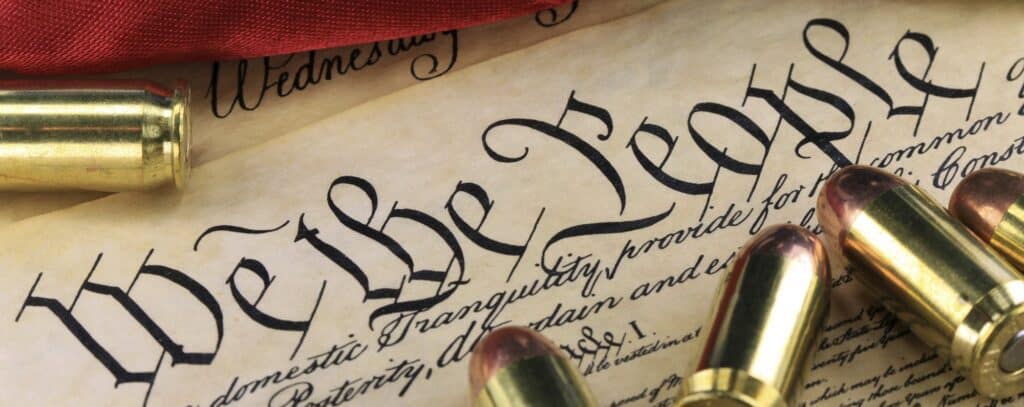Second Amendment:
"A well regulated Militia, being necessary to the security of a free State, the right of the people to keep and bear Arms, shall not be infringed."
For over 200 years, despite extensive debate and much legislative action with respect to regulation of the purchase, possession, and transportation of firearms, as well as proposals to substantially curtail ownership of firearms, there was no definitive resolution by the courts of just what right the Second Amendment protects. The Second Amendment is naturally divided into two parts: its prefatory clause (A well regulated Militia, being necessary to the security of a free State
) and its operative clause (the right of the people to keep and bear Arms shall not be infringed
). To perhaps oversimplify the opposing arguments, the states’ rights
thesis emphasized the importance of the prefatory clause, arguing that the purpose of the clause was to protect the states in their authority to maintain formal, organized militia units. The individual rights
thesis emphasized the operative clause, so that individuals would be protected in the ownership, possession, and transportation of firearms.1 Whatever the Amendment meant, it was seen as a bar only to federal action, not state2 or private3 restraints.
One of the Second Amendment cases that the Court has heard, and until recently the only case challenging a congressional enactment, seemed to affirm individual protection but only in the context of the maintenance of a militia or other such public force. In United States v. Miller,4 the Court sustained a statute requiring registration under the National Firearms Act of sawed-off shotguns. After reciting the original provisions of the Constitution dealing with the militia, the Court observed that [w]ith obvious purpose to assure the continuation and render possible the effectiveness of such forces the declaration and guarantee of the Second Amendment were made. It must be interpreted with that end in view.
5 The significance of the militia, the Court continued, was that it was composed of civilians primarily, soldiers on occasion.
It was upon this force that the states could rely for defense and securing of the laws, on a force that comprised all males physically capable of acting in concert for the common defense,
who, when called for service . . . were expected to appear bearing arms supplied by themselves and of the kind in common use at the time.
6 Therefore, [i]n the absence of any evidence tending to show that possession or use of a ‘shotgun having a barrel of less than 18 inches in length’ at this time has some reasonable relationship to the preservation or efficiency of a well-regulated militia, we cannot say that the Second Amendment guarantees the right to keep and bear such an instrument. Certainly it is not within judicial notice that this weapon is any part of the ordinary military equipment or that its use could contribute to the common defense.
7
After that decision, Congress placed greater limitations on the receipt, possession, and transportation of firearms,8 and proposals for national registration or prohibition of firearms altogether have been made.9 Miller, however, shed little light on the validity of such proposals. Pointing out that interest in the character of the Second Amendment right has recently burgeoned,
Justice Thomas, concurring in the Court’s invalidation (on other grounds) of the Brady Handgun Violence Prevention Act, questioned whether the Second Amendment bars federal regulation of gun sales, and suggested that the Court might determine at some future date . . . whether Justice Story was correct . . . that the right to bear arms has justly been considered, as the palladium of the liberties of a republic.’
10
It was not until 2008 that the Supreme Court definitively came down on the side of an individual rights
theory. Relying on new scholarship regarding the origins of the Amendment,11 the Court in District of Columbia v. Heller12 confirmed what had been a growing consensus of legal scholars—that the rights of the Second Amendment adhered to individuals. The Court reached this conclusion after a textual analysis of the Amendment,13 an examination of the historical use of prefatory phrases in statutes, and a detailed exploration of the 18th century meaning of phrases found in the Amendment. Although accepting that the historical and contemporaneous use of the phrase keep and bear Arms
often arose in connection with military activities, the Court noted that its use was not limited to those contexts.14 Further, the Court found that the phrase well regulated Militia
referred not to formally organized state or federal militias, but to the pool of able-bodied men
who were available for conscription.15 Finally, the Court reviewed contemporaneous state constitutions, post-enactment commentary, and subsequent case law to conclude that the purpose of the right to keep and bear arms extended beyond the context of militia service to include self-defense.
Using this individual rights theory,
the Court struck down a District of Columbia law that banned virtually all handguns, and required that any other type of firearm in a home be dissembled or bound by a trigger lock at all times. The Court rejected the argument that handguns could be banned as long as other guns (such as long-guns) were available, noting that, for a variety of reasons, handguns are the most popular weapon chosen by Americans for self-defense in the home.
16 Similarly, the requirement that all firearms be rendered inoperable at all times was found to limit the core lawful purpose of self-defense.
17 However, the Court specifically stated (albeit in dicta) that the Second Amendment did not limit prohibitions on the possession of firearms by felons and the mentally ill, penalties for carrying firearms in schools and government buildings, or laws regulating the sales of guns.18 The Court also noted that there was a historical tradition of prohibiting the carrying of dangerous and unusual weapons
that would not be affected by its decision.19 The Court, however, declined to establish the standard by which future gun regulations would be evaluated.20 And, more importantly, because the District of Columbia is a federal enclave, the Court did not have occasion to address whether it would reconsider its prior decisions that the Second Amendment does not apply to the states.
The latter issue was addressed in McDonald v. Chicago,21 where a plurality of the Court, overturning prior precedent, found that the Second Amendment is incorporated through the Fourteenth Amendment and is thus enforceable against the states.22 Relevant to this question, the Court examined whether the right to keep and bear arms is fundamental to our scheme of ordered liberty
23 or deeply rooted in this Nation’s history and tradition
.24 The Court, relying on historical analysis set forth previously in Heller, noted the English common law roots of the right to keep arms for self-defense25 and the importance of the right to the American colonies, the drafters of the Constitution, and the states as a bulwark against over-reaching federal authority.26 Noting that by the 1850s the perceived threat that the National Government would disarm the citizens had largely faded, the Court suggested that the right to keep and bear arms became valued principally for purposes of self-defense, so that the passage of Fourteenth Amendment, in part, was intended to protect the right of ex-slaves to keep and bear arms. While it was argued by the dissent that this protection would most logically be provided by the Equal Protection Clause, not by the Due Process Clause,27 the plurality also found enough evidence of then-existent concerns regarding the treatment of black citizens by the state militia to conclude that the right to bear arms was also intended to protect against generally-applicable state regulation.
Footnotes
- Jump to essay-1A sampling of the diverse literature in which the same historical, linguistic, and case law background shows the basis for strikingly different conclusions includes: , 97th Congress, 2d Sess., The Right to Keep and Bear Arms (Comm. Print 1982); , Handgun Prohibition and the Original Meaning of the Second Amendment (1984); Gun Control and the Constitution: Sources and Explorations on the Second Amendment (Robert J. Cottrol ed., 1993); , That Every Man Be Armed: The Evolution of a Constitutional Right (1984); Symposium, Gun Control, 49 Law & Contemp. Probs. 1 (1986); , The Embarrassing Second Amendment, 99 Yale L.J. 637 (1989); , To Keep and Bear Arms: The Origins of an Anglo-American Right (1994); , A Critical Guide to the Second Amendment, 62 Tenn. L. Rev. 461 (1995); , The Second Amendment and the Personal Right to Bear Arms, 43 Duke L.J. 1236 (1994); Symposium, Symposium on the Second Amendment: Fresh Looks, 76 Chi.-Kent L. Rev. 3 (2000).
- Jump to essay-2Presser v. Illinois, 116 U.S. 252, 265 (1886). See also Miller v. Texas, 153 U.S. 535 (1894); Robertson v. Baldwin, 165 U.S. 275, 281–82 (1897). The non-application of the Second Amendment to the states was reaffirmed in Quilici v. Village of Morton Grove, 695 F.2d 261 (7th Cir. 1982), cert. denied, 464 U.S. 863 (1983).
- Jump to essay-3United States v. Cruikshank, 92 U.S. 542 (1876).
- Jump to essay-4307 U.S. 174 (1939). The defendants had been released on the basis of the trial court determination that prosecution would violate the Second Amendment and no briefs or other appearances were filed on their behalf; the Court acted on the basis of the government’s representations.
- Jump to essay-5307 U.S. at 178.
- Jump to essay-6307 U.S. at 179.
- Jump to essay-7307 U.S. at 178. In Cases v. United States, 131 F.2d 916, 922 (1st Cir. 1942), cert. denied, 319 U.S. 770 (1943), the court, upholding a similar provision of the Federal Firearms Act, said,
Apparently, then, under the Second Amendment, the Federal Government can limit the keeping and bearing of arms by a single individual as well as by a group of individuals, but it cannot prohibit the possession or use of any weapon which has any reasonable relationship to the preservation or efficiency of a well-regulated militia.
See Lewis v. United States, 445 U.S. 55, 65 n.8 (1980) (dictum: Miller holds that theSecond Amendment guarantees no right to keep and bear a firearm that does not have ‘some reasonable relationship to the preservation or efficiency of a well regulated militia’
). See also Hickman v. Block, 81 F.3d 98 (9th Cir.) (plaintiff lacked standing to challenge denial of permit to carry concealed weapon, because Second Amendment is a right held by states, not by private citizens), cert. denied, 519 U.S. 912 (1996); United States v. Gomez, 92 F.3d 770, 775 n.7 (9th Cir. 1996) (interpreting federal prohibition on possession of firearm by a felon as having a justification defenseensures that [the provision] does not collide with the Second Amendment
). United States v. Wright, 117 F.3d 1265 (11th Cir. 1997), cert. denied, 522 U.S. 1007 (1997) (member of Georgia unorganized militia unable to establish that his possession of machine guns and pipe bombs bore any connection to the preservation or efficiency of a well regulated militia). - Jump to essay-8Enacted measures include the Gun Control Act of 1968. 82 Stat. 226, 18 U.S.C. §§ 921-928. The Supreme Court’s dealings with these laws have all arisen in the context of prosecutions of persons purchasing or obtaining firearms in violation of prohibitions against such conduct by convicted felons. Lewis v. United States, 445 U.S. 55 (1980); Barrett v. United States, 423 U.S. 212 (1976); Scarborough v. United States, 431 U.S. 563 (1977); United States v. Bass, 404 U.S. 336 (1971).
- Jump to essay-9E.g., National Commission on Reform of Federal Criminal Laws, Working Papers 1031–1058 (1970), and Final Report 246–247 (1971).
- Jump to essay-10Printz v. United States, 521 U.S. 898, 937–39 (1997) (quoting 3 Commentaries § 1890, p. 746 (1833)). Justice Scalia, in extra-judicial writing, has sided with the individual rights interpretation of the Amendment. See , A Matter of Interpretation, Federal Courts and the Law, 136–37 n.13 (A. Gutmann, ed., 1997) (responding to Professor Tribe’s critique of
my interpretation of the Second Amendment as a guarantee that the Federal Government will not interfere with the individual’s right to bear arms for self-defense
). - Jump to essay-11, The Commonplace Second Amendment, 73 N. Y.U. L. Rev. 793 (1998); , Was the Right to Keep and Bear Arms Conditioned on Service in an Organized Militia?, 83 Tex. L. Rev. 237 (2004); ,
Necessary to the Security of a Free State,
83 Notre Dame L. Rev. 1 (2007); What DidBear Arms
Mean in the Second Amendment?, 6 Georgetown J. L. & Pub. Policy (2008). - Jump to essay-12554 U.S. 570 (2008).
- Jump to essay-13The
right of the people,
for instance, was found in other places in the Constitution to speak to individual rights, not to collective rights (those that can only be exercised by participation in a corporate body). Id. at 578–80. - Jump to essay-14Id. at 580–91. In so doing, the Heller Court rejected the argument that
only those weapons useful in warfare are protected
by the Second Amendment, as thetraditional militia was formed from a pool of men bringing arms ‘in common use at the time’ for lawful purposes like self-defense.
Id. at 624–25 (quoting United States v. Miller, 307 U.S. 174, 179 (1939)) (We therefore read Miller to say only that the Second Amendment does not protect those weapons not typically possessed by law-abiding citizens for lawful purposes, such as short-barreled shotguns.
); see also Caetano v. Massachusetts, No. 14-10078, Slip Op. (March 21, 2016) (vacating a ruling by a state court that a ban on stun guns did not violate the Second Amendment because such weapons were notreadily adaptable to use in the military.
). - Jump to essay-15Heller, 554 U.S. at 594–96. Similarly, the phrase
security of a free state
was found to refer not to the defense of a particular state, but to the protection of the national polity. Id. at 596–98. - Jump to essay-16Id. at 628–29. Subsequently, in Caetano v. Massachusetts, the Court emphasized that, under Heller, the protections of the Second Amendment extend to firearms that were not in existence at the time of the Framers. See Caetano, No. 07-290, Slip Op. at 1028 (per curiam) (vacating and remanding a Massachusetts state court ruling upholding a state law that prohibited the possession of stun guns, in part, on the grounds that stun guns were not in common use when the Second Amendment was adopted).
- Jump to essay-17Heller, No. 07-290, Slip Op. at 630.
- Jump to essay-18Id. at 626.
- Jump to essay-19Id. at 627. But see Caetano, No. 14-10078, Slip Op. at 1028 (rejecting, as inconsistent with Heller, the view that a weapon may be deemed
unusual
if it was not in common use at the time when the Second Amendment was adopted, as well as the view that the Second Amendment only protects weapons that areuseful in warfare
). - Jump to essay-20Heller, No. 07-290, Slip Op. at 629 n.27 (discussing the non-application of rational basis review).
- Jump to essay-21561 U.S. 742 (2010).
- Jump to essay-22The portion of the opinion finding incorporation was authored by Justice Alito, and joined by Chief Justice Roberts, Justice Scalia and Justice Kennedy. Justice Thomas declined to join the plurality's opinion as regards incorporation under the Due Process Clause. Instead, Justice Thomas, alone among the Justices, would have found that the Second Amendment is applicable to the states under the Privileges or Immunities Clause. For a more detailed discussion of incorporation and the Privileges or Immunities Clause, see supra Bill of Rights, Fourteenth Amendment and Fourteenth Amendment, Privileges or Immunities.
- Jump to essay-23Duncan v. Louisiana, 391 U.S. 145, 149 (1968).
- Jump to essay-24Washington v. Glucksberg, 521 U.S. 702, 721 (1997) (internal quotation marks omitted).
- Jump to essay-25McDonald, 561 U.S. at 742, 768 (2010) (noting that Blackstone had asserted that the right to keep and bear arms was
one of the fundamental rights of Englishmen
). - Jump to essay-26561 U.S. 742, 768–70 (2010).
-
Jump to essay-27561 U.S. 742, 878–80 (2010) (Breyer, J., dissenting).




